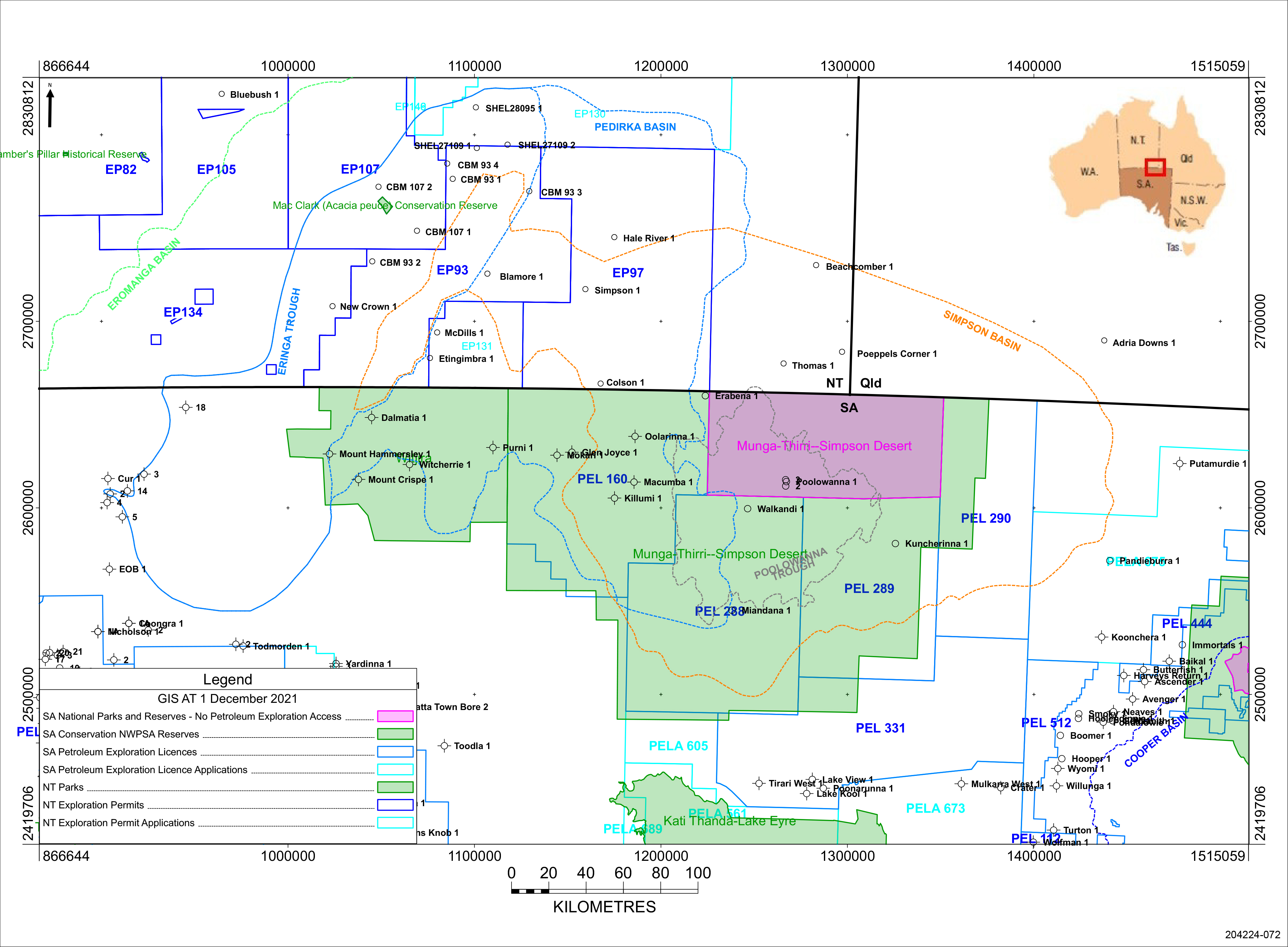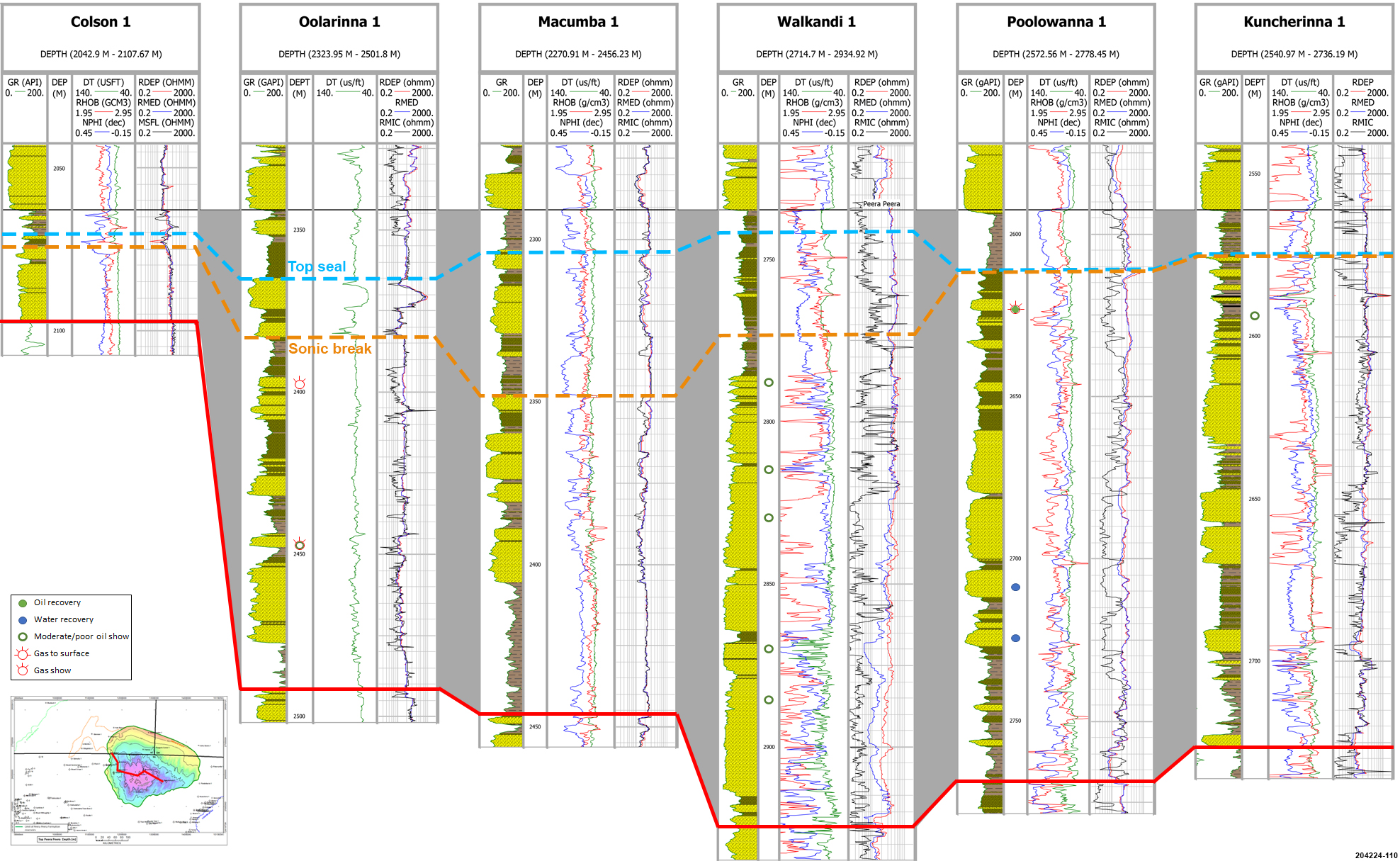Summary
| PLAY | Peera Peera Formation |
| SOUTH AUSTRALIA BASIN | Simpson |
| LOCATION | Poolowanna Trough |
| AGE | Middle-Late Triassic |
| RESERVOIR | Peera Peera Fm. sandstone |
| SEAL | Peera Peera Fm. intraformational organic-rich shales |
| SOURCE ROCK/S | Peera Peera Fm., Lower Poolowanna Fm., Purni Fm. |
| HYDROCARBON PHASE | Gas/light oil |
| PRODUCTION | None; gas flowed at RTSM and slightly oil cut mud recovered in Poolowanna 1 |
| HYDROCARBON FLOW RATES | No rate proven other than gas to surface at RTSTM |
| POTENTIAL VOLUMES | There is no estimate of undiscovered resources |
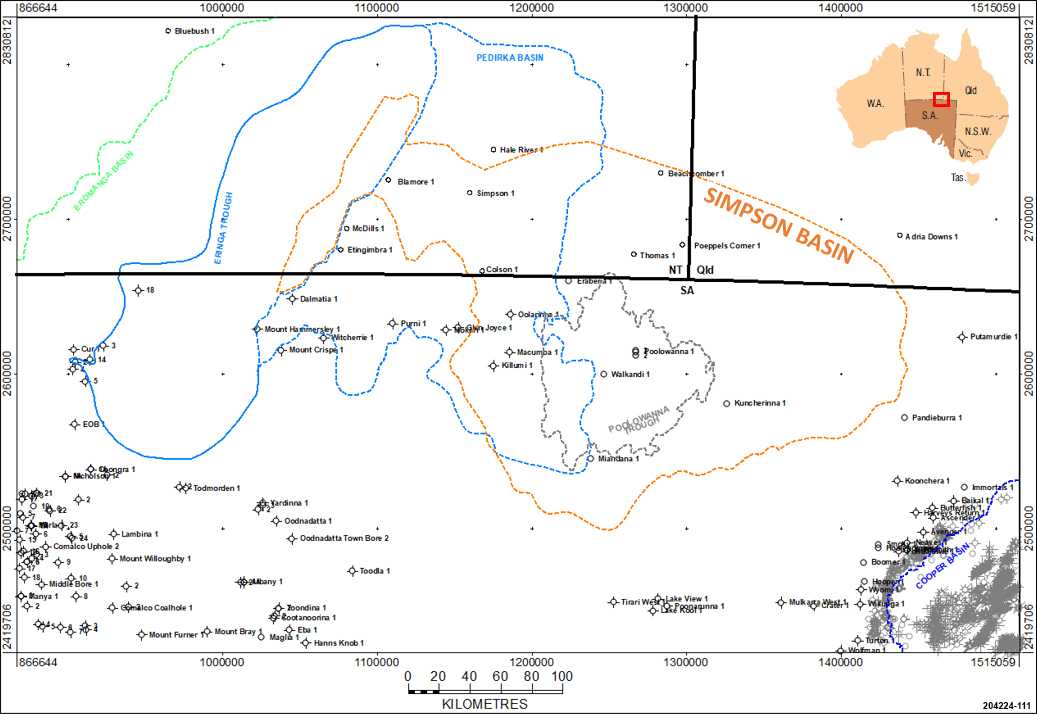
Location of the Simpson Basin in central Australia.
The Simpson Basin covers approximately ~57,500 km2 in South Australia, Northern Territory and Queensland, with around 34,000 km2 in South Australia. It is a circular, poorly defined intracratonic depression with one major depocentre in the Poolowanna Trough. The basin overlies Palaeozoic and older basins and is overlain by the Jurassic to Cretaceous Eromanga Basin.
During the Triassic, the western Pedirka Basin area remained elevated and was eroded, while the eastern portion subsided to form a depocentre, the Poolowanna Trough. Regional uplift and erosion terminated deposition in the Simpson Basin at the end of the Early to Middle Triassic. The main episode of structuring occurred in the Early Tertiary when E–W compression produced major faulted anticlines.
The Peera Peera Formation is Middle-Late Triassic in age and is the youngest interval prior to the significant subsidence of the Eromanga Basin through the Jurassic and Cretaceous. It was deposited in a high-sinuosity fluvial environment with possible development of lakes on the floodplain (Alexander et al, 2007). The lower boundary is conformable with the Early-Middle Triassic Walkandi Formation, while the upper boundary is the unconformity at the base of the Eromanga Basin. The Peera Peera Formation correlates with the Cuddapan Formation of the Cooper region, and can be subdivided into three facies:
- the upper unit is characterised by black carbonaceous shale, coal and thin sandstone interbeds;
- the middle unit is sand-prone with fining upwards cycles; and
- and the lowermost is siltstone and shale-dominated, with minor thin sandstone and rare coal.
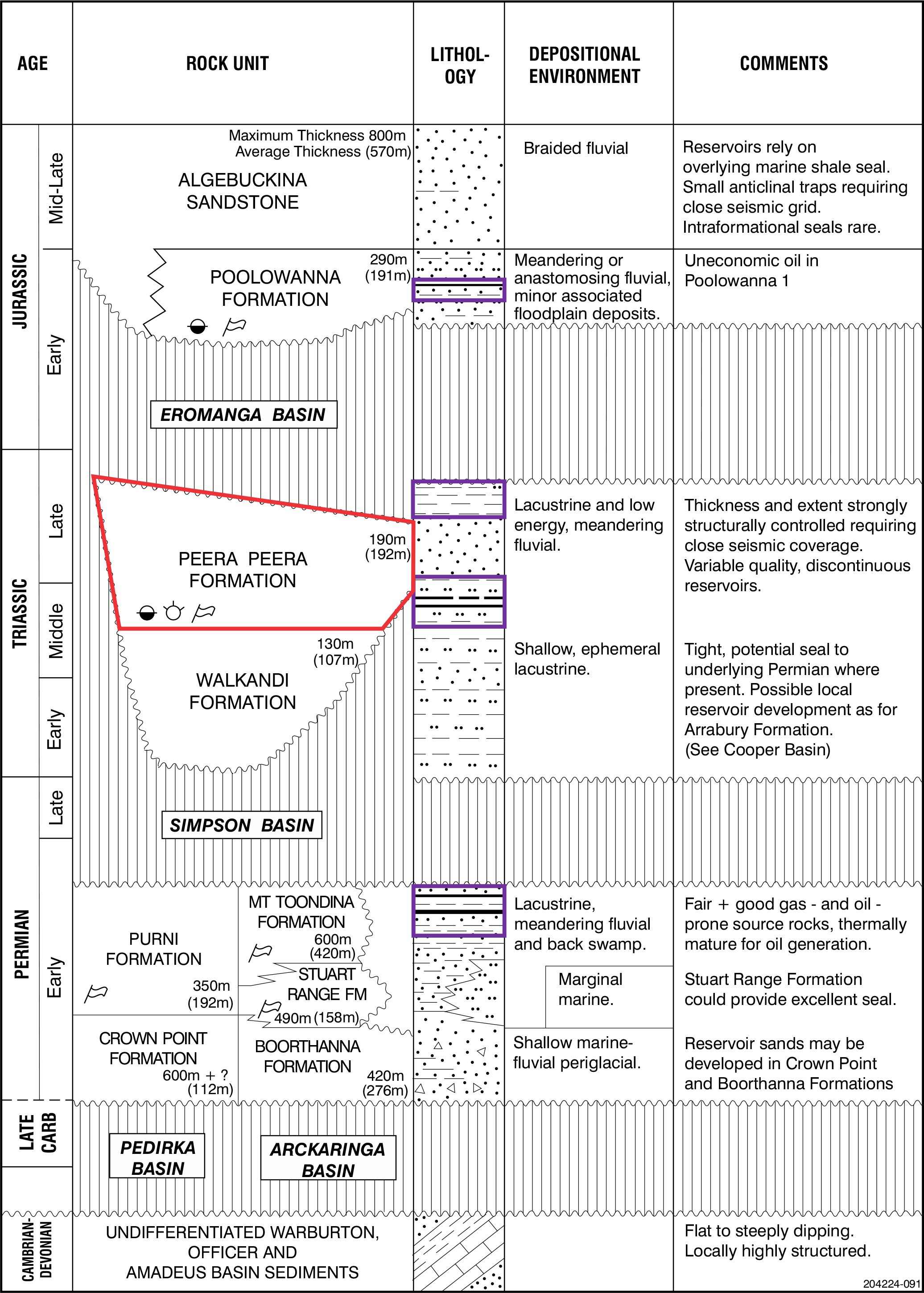
Geological summary of the Arckaringa, Pedirka and Simpson basins. Peera Peera Formation highlighted in red. Potential source rocks highlighted in purple.
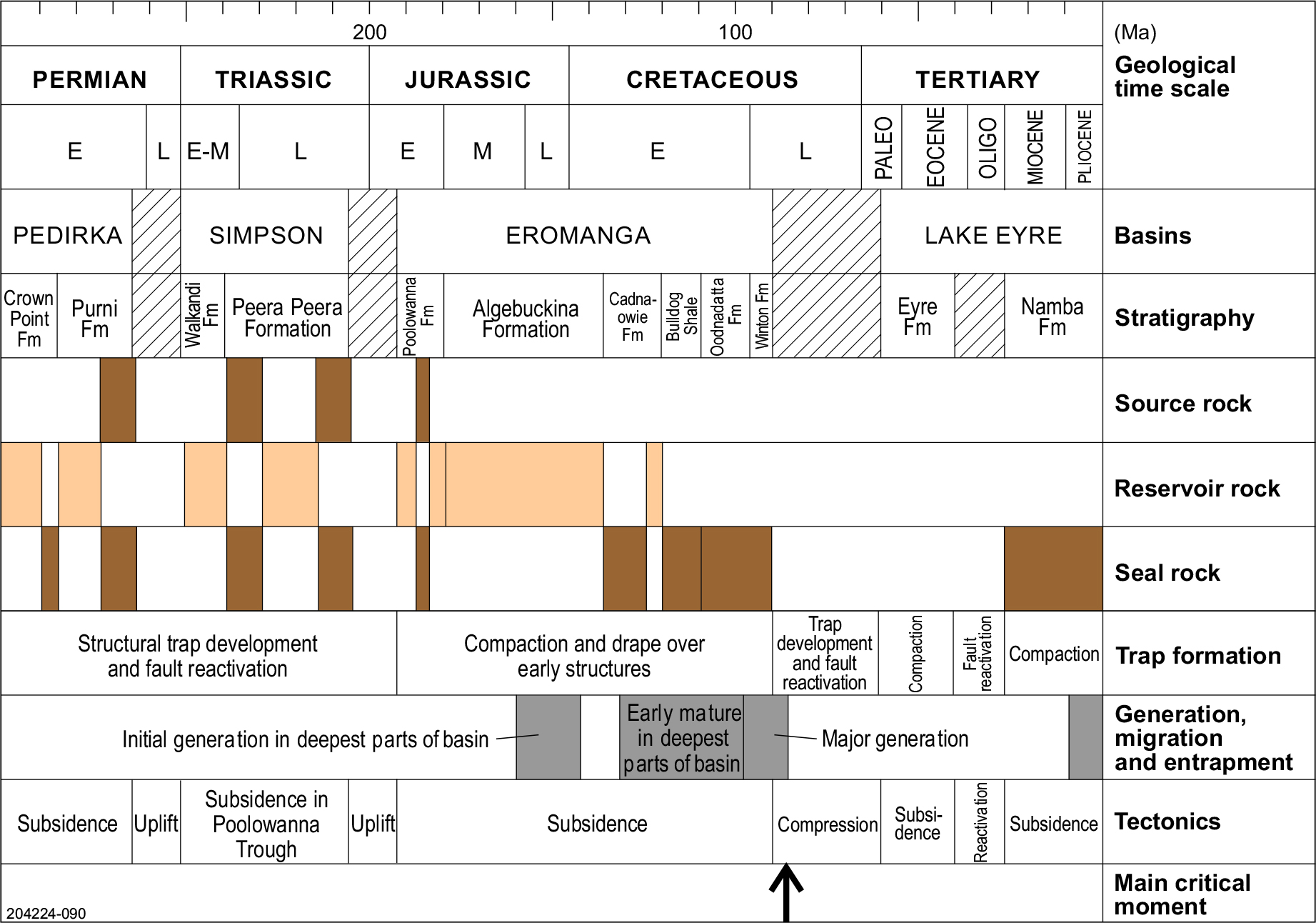
Key petroleum system events in the Pedirka Basin/Simpson Basin/Poolowanna Trough area
The key petroleum events chart for the Pedirka Basin/Simpson Basin/Poolowanna Trough area is similar to that for the Cooper-Eromanga Basins in that the critical moment was in the Late Cretaceous at the end of deposition of the Winton Formation, the last stage of the Eromanga Basin prior to uplift and erosion. Basin modelling suggests that major hydrocarbon generation and expulsion commenced around 100 Ma (Ambrose et al, 2007) and lasted around 10-15Ma, so formation of structures prior to this was critical.
Structural reactivation occurred in the Miocene, and it is likely that this breached seals for some hydrocarbon accumulations where fault seal was critical, which is likely to have been the case at Poolowanna 1. Therefore, exploration is required of more subtle structures not affected by the reactivation in the Miocene.
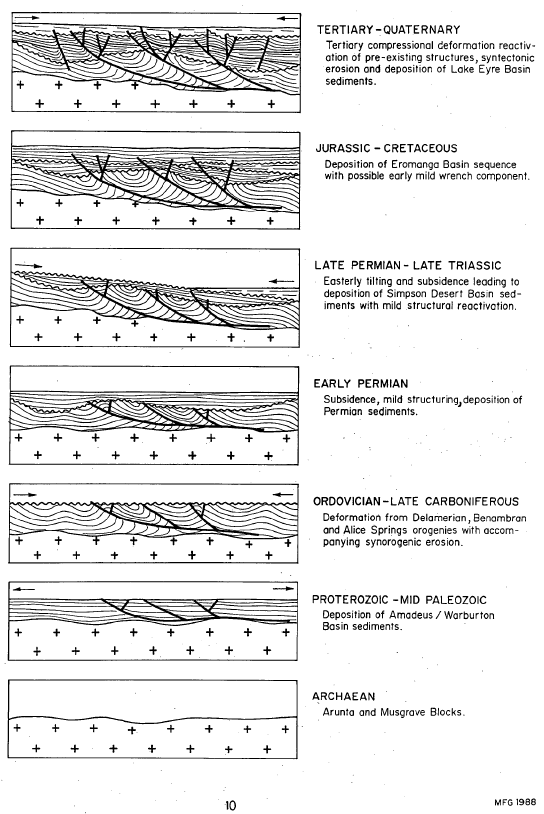
Schematic structural history of the Pedirka Basin-Poolowanna Trough area (Giuliano, 1988)
Petroleum exploration commenced in the 1950s when licences covering the Cooper and Eromanga basins were first acquired by Santos, who went against conventional wisdom that commercial accumulations of oil would not be found in Mesozoic formations within the Great Artesian Basin.
Initial exploration involved surface mapping, stratigraphic drilling, aerial surveys, gravity and aeromagnetic surveys and seismic. The first petroleum well was drilled in 1959 and Cooper Basin gas was discovered in 1963.
The first commercial hydrocarbon to flow from the Eromanga Basin was gas produced from Namur 1 in 1976 (Cooper region). Oil was discovered in 1977 with uneconomic flows of oil from basal Jurassic and Triassic sediments in Poolowanna 1 in the Poolowanna Trough. The first economic oil flow was recorded from Strzelecki 3 (Cooper region) in the following year and this stimulated a major oil exploration program.
Exploration activity intensified in the Poolowanna Trough/Pedirka Basin area in the 1980s in response to the Poolowanna discovery. Six seismic surveys were carried out and five wells were drilled, three in 1985 and two in 1988.
Seismic reinterpretation by Santos indicated that five of the previously drilled wells were not valid structural tests being outside closure at all objectives. Of the 1985 wells, Oolarinna 1 had no independent fault closure and Glen Joyce 1 had little closure.
It should be noted that no wells have been drilled in the South Australian sector since the 1980s, although Central Petroleum drilled Blamore 1 and Simpson 1 in the Northern Territory in 2008. Exploration in the area would benefit from current ideas on the geology of the petroleum systems in the Cooper Basin region and modern technology and interpretation techniques.
Hydrocarbon shows have been recorded in most wells within the Simpson Basin region, including within the Peera Peera Formation. However, oil and gas has been recovered from only 2 wells, the Poolowanna and Peera Peera Formations in Poolowanna 1, and the Poolowanna Formation in Poolowanna 3.
The classification scheme used by Geoscience Australia has been used to determine the type of show present in a formation in the tables below.
Hydrocarbon shows and flow rates in South Australian wells in the Poolowanna Trough/Simpson Basin/Pedirka Basin region:
| Well | Year/Result | Formation | Shows/Recovery | Flow rate |
|---|---|---|---|---|
| Pandieburra 1 |
1963 Oil shows | Peera Peera (?) | Minor fluorescence | |
| Dullingari Group | Minor fluorescence. Recovered 190ft mud-cut water with a trace of hydrocarbons. | |||
| Mokari 1 |
1966 Dry hole | Poolowanna | Gas show; mudlog gas 14 times background. Minor fluorescence. Water to surface (WTS) in 12 mins. | 387 cu ft/hr = rate of 1,654BWPD |
| Purni | Minor fluorescence. WTS in 17 mins. | Reported rate of 387 cu ft/hr | ||
| Poolowanna 1 |
1977 Oil shows | Poolowanna | Gas to surface (GTS) in 125 mins. Oil and water to surface in 3hrs 55 mins. Recovered 71¼ barrels water and 9½ barrels oil, 36.9o API gravity, with pour point of 41o C. | Gas at rate too small to measure (RTSTM). Calculated flow rate of 96BOPD |
| Peera Peera | Oil show. GTS in 120mins. Recovered 110ft mud and condensate. | Gas at RTSTM | ||
| Walkandi 1 |
1981 Oil shows | Poolowanna | Oil shows. Recovered 650ft muddy water and 1450ft gas-cut slightly muddy water. | |
| Peera Peera | Oil shows. Recovered 46ft rat hole mud and 31ft slightly gas-cut mud. | |||
| Walkandi | Oil shows. Recovered 480ft water cushion and 4900ft slightly gas-cut mud. | |||
| Erabena 1 |
1981 Oil shows | Poolowanna | Minor fluorescence | |
| Peera Peera | Minor fluorescence | |||
| Kuncherinna 1 |
1981/2 Oil shows | Poolowanna | Recovered 90ft rathole mud with trace of oil | |
| Peera Peera | Minor fluorescence | |||
| Poolowanna 2 |
1985 Oil shows | Wallumbilla | Minor fluorescence | |
| Cadna-owie | Minor fluorescence | |||
| Algebuckina | Minor fluorescence | |||
| Poolowanna | Minor fluorescence. Recovered 1026ft VSGCMW, 306ft SGCM. | |||
| Peera Peera | Minor fluorescence. Recovered 240ft very slightly gas-cut muddy water. | |||
| Oolarinna 1 |
1985 Dry hole | Poolowanna | Minor fluorescence | |
| Peera Peera | Recovered 5310ft gas-cut water (slightly muddy at top) | |||
| Killumi 1 |
1985 Dry hole | Poolowanna | Minor fluorescence | |
| Miandana 1 |
1985 Oil shows | Poolowanna | Minor fluorescence | |
| Poolowanna 3 |
1989 Oil shows | Algebuckina | Minor fluorescence | |
| Poolowanna | Minor fluorescence. GTS in 141 mins. Recovered 5550ft slightly oil and gas-cut water and 2290ft water in 171 mins. | Gas at RTSTM. 80BWPD. | ||
| Peera Peera | Minor fluorescence |
Hydrocarbon shows in Northern Territory wells in the Poolowanna Trough/Simpson Basin/Pedirka Basin region:
| Well | Year/Result | Formation | Shows/Recovery |
|---|---|---|---|
| McDills 1 | 1965 Trace hydrocarbon indication | Purni | Minor fluorescence |
| Colson 1 | 1978 Trace hydrocarbon indication | Poolowanna | Minor fluorescence |
| Peera Peera | Minor fluorescence | ||
| Warburton | Log interpretation “oil show” | ||
| Thomas 1 | 1981 Oil indication | Poolowanna | Residual oil. Recovered 4951ft water with minor mud in 68 mins. |
| Poeppels Corner 1 | 1984 Trace hydrocarbon indication | Algebuckina | Minor fluorescence |
| Poolowanna | Minor fluorescence | ||
| Peera Peera | Minor fluorescence | ||
| Beachcomber 1 | 1988 Trace hydrocarbon indication | Cadna-owie | Minor fluorescence in coals |
| Algebuckina | Minor fluorescence in coals | ||
| Peera Peera | Minor fluorescence in coals | ||
| Blamore 1 | 2008 Oil and gas show | Algebuckina | Residual oil |
| Walkandi | Minor fluorescence | ||
| Purni | Gas shows in coals. Trace fluorescence. | ||
| CBM 93 1 | 2008 Trace hydrocarbon indication | Purni | Minor fluorescence |
| Simpson 1 | 2008 Trace hydrocarbon indication | Poolowanna | Minor fluorescence |
| Walkandi | Minor fluorescence |
Petroleum exploration permits, regional reserves and conservation parks in the Poolowanna Trough area as at December 2021
The Peera Peera Formation play exists in the Simpson Basin, proven by gas and light oil recovered in Poolowanna 1 in South Australia.
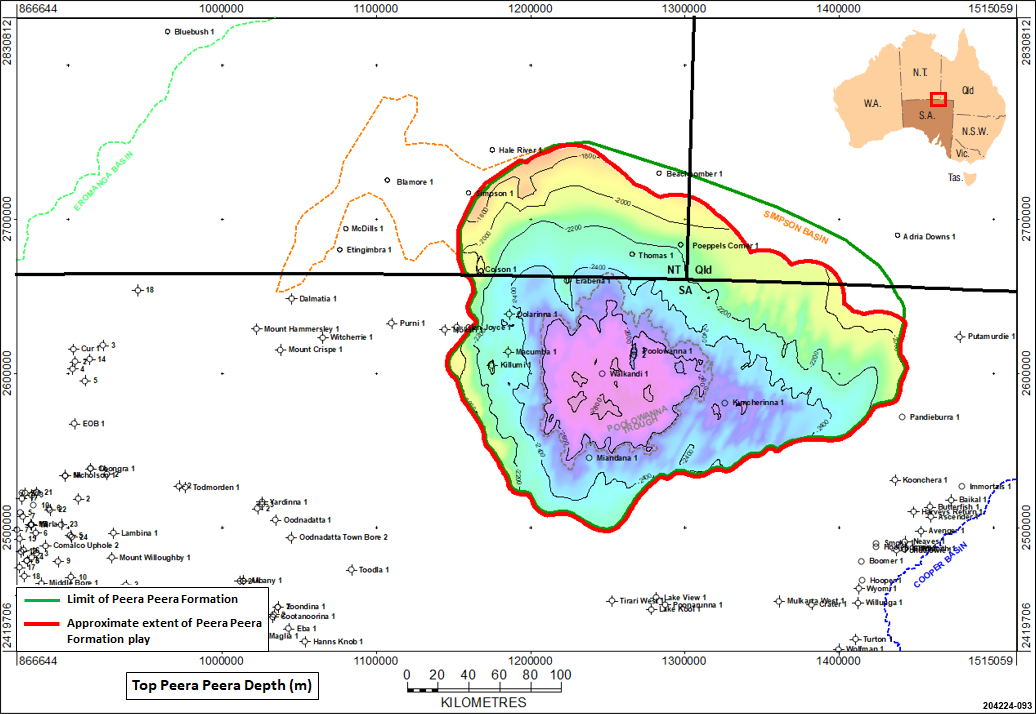
Approximate extent of the Peera Peera Formation play in the Simpson Basin
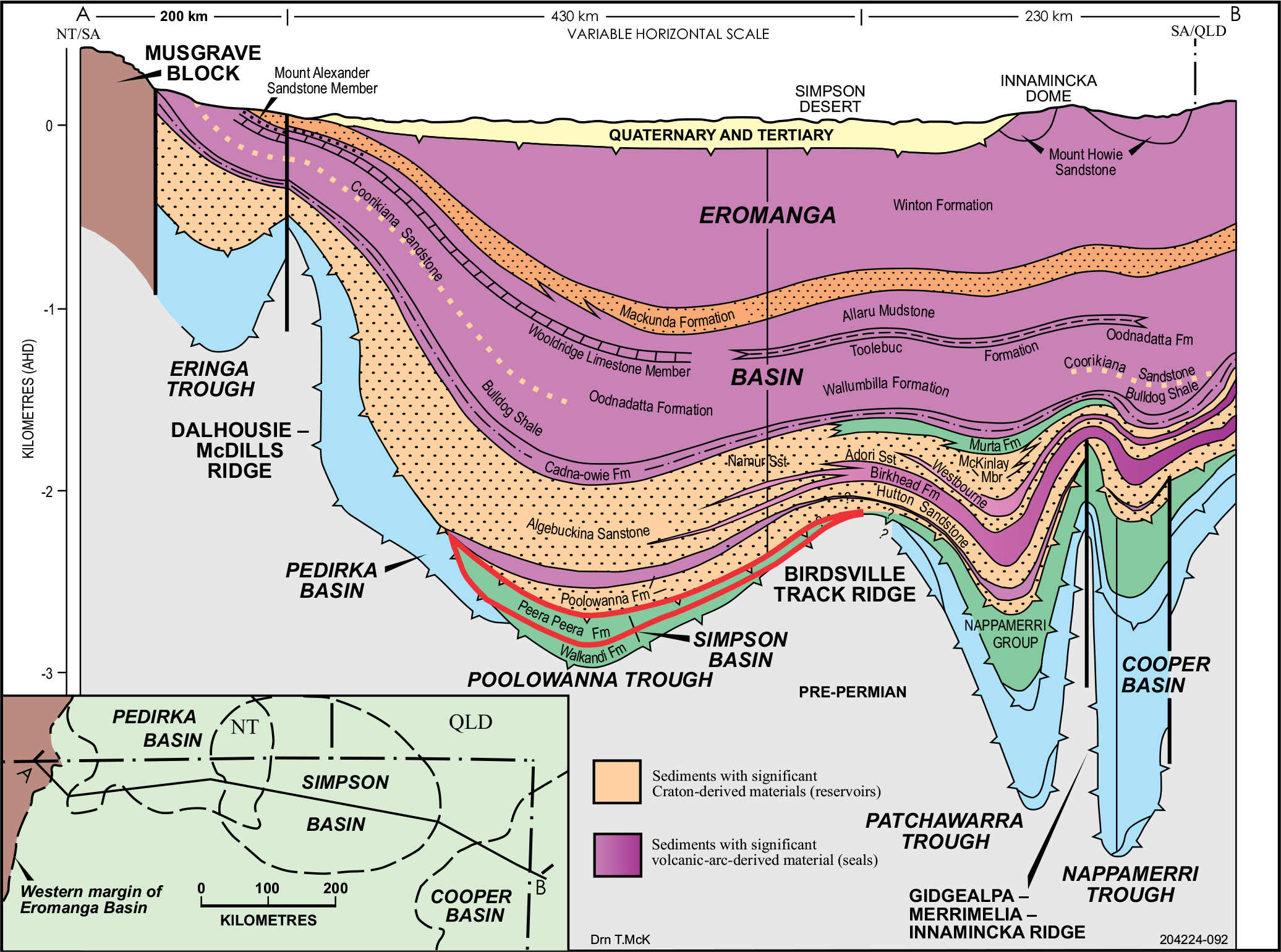
Schematic section across the Eromanga, Pedirka and Simpson basins. Peera Peera Fm in the Poolowanna Trough highlighted in red.
Poolowanna 1 (1977)
Poolowanna 1 was drilled as a rank wildcat 77 miles from the nearest well to test a faulted north-south elongate anticline. The well recovered oil from the Poolowanna Formation and gas/oil-cut mud from the Triassic Peera Peera Formation, although in non-commercial quantities so the well was plugged and abandoned.
The Peera Peera Formation in Poolowanna 1 is the type section for the formation in the Simpson Basin.
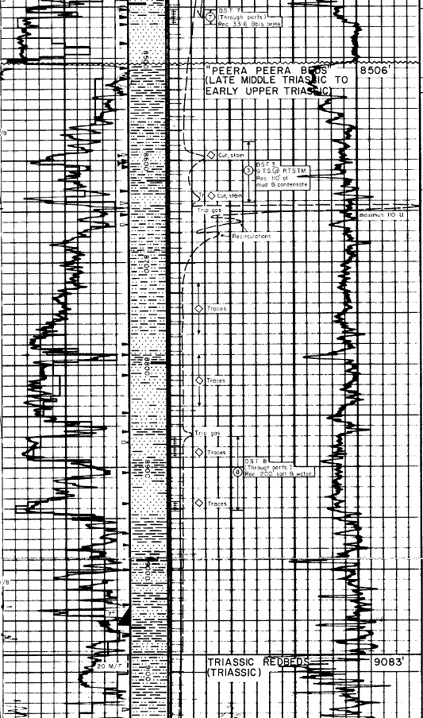
Peera Peera Formation in Poolowanna 1 (excerpt from Composite Log)
Two tests in the Peera Peera Formation were conducted in Poolowanna 1, details from the Well Completion Report (WCR):
Open hole test:
- DST 3: 8,585 - 8,642ft, Peera Peera Formation; weak blow, gas to surface (GTS) after 2 hours at rate too small to measure (RTSTM), recovered 110ft mud and condensate; gas/light oil zone, the tested interval is effectively tight.
Cased hole test:
- DST 8: 8,870 - 8,878ft, 8,880 - 8,890ft, 8,934 - 8,944ft Peera Peera Formation; tool opened with fair blow, decreasing to weak and steady duration of 4-hour flow period, no GTS; recovered 200ft salt water, no hydrocarbons; tested interval tight, water-saturated.
Oil type:
- “The oil recovered from D.S.T. No. 3 from the Triassic contains significant quantities of lighter hydrocarbons, in the range nC7 to nC10, and a second broad peak in the ranges nC16 to nC19 with little above nC31 present. … there is no odd to even preference.”
- Different oil to that recovered from the Poolowanna Fm above in Poolowanna 1, which contains “hydrocarbons from nC9 to nC37 with peak in the nC22 to nC25 range”.
“It is notable that:
- there is a remarkable absence of gas in association with the oil
- the oil recovered from D.S.T. #2, and the fracturing present in Core #3 suggest the presence of oil in fractures over much of the Jurassic section.
- This oil does not appear to have saturated the sandstones, except for the thin sandstone between 8,394 and 8,397 feet.
- Because of the interspersing of oil and water in complex association, electric logs are not readily interpreted.”
Two appraisal wells were drilled following the discovery of oil in Poolowanna 1, although both were designated as exploration wells on different culminations on the greater Poolowanna structure:
Poolowanna 2 (1985):
- WCR summary: “Six DST’s were conducted prior to TD. No open hole test recovered significant hydrocarbons. … Log interpretation indicates all potential reservoir sands are water saturated. No pay is mapped.”
- This refers to reservoirs in the Upper Poolowanna, Lower Poolowanna and Peera Peera
- Fluorescence was encountered in the Poolowanna Formation
- The well was plugged and abandoned
Poolowanna 3 (1989):
- WCR summary: “Three DST’s were run in response to shows whilst drilling in the Poolowanna Formation. DST 1 over the main target recovered only rat hole mud. DST recovered a trace film of oil. DST 3 flowed water at 80 BPD and recovered gas and oil cut water. Oil shows were recorded over the Peera-Peera Formation, but the sandstones are silicified and tight. … No net pay is mapped.”
- The well was plugged and completed as an Algebuckina water well
Analogue: Telopea Field, South Australian Cooper Basin
The Telopea Field on the Deramookoo Platform, northern Cooper Basin area, has produced over 820 thousand barrels of oil from the Tinchoo Formation. Even though the Peera Peera Formation in the Simpson Basin is the equivalent of the Cuddapan Formation in the Cooper production from the Tinchoo is a good analogue for the Peera Peera.
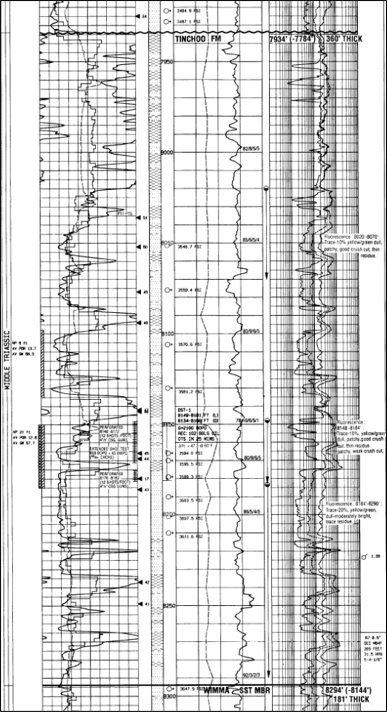
Tinchoo Formation that has produced 422kbo in Telopea 1, South Australian Cooper Basin (excerpt from Composite Log)
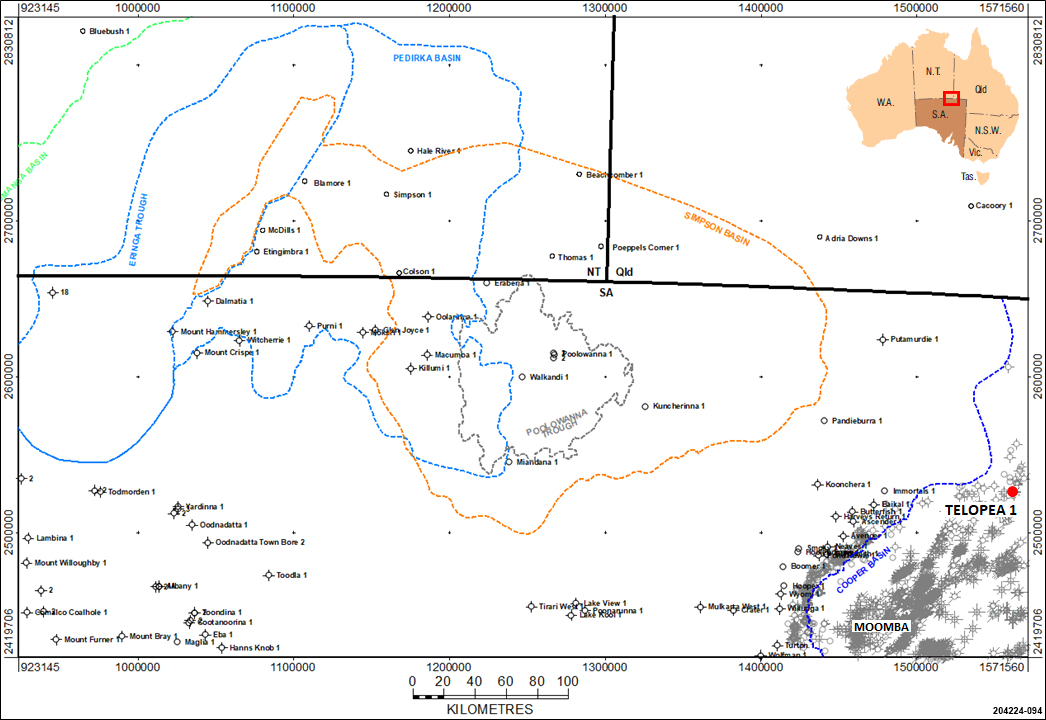
Location of Telopea 1 in relation to the Poolowanna Trough
The Peera Peera Formation was deposited in a high-sinuosity fluvial environment with possible development of lakes on the floodplain (Alexander et al, 2007). The Peera Peera Formation correlates with the Cuddapan Formation of the Cooper region, and can be subdivided into three facies:
- the upper unit is characterised by black carbonaceous shale, coal and thin sandstone interbeds;
- the middle unit is sand-prone with fining upwards cycles; and
- and the lowermost is siltstone and shale-dominated, with minor thin sandstone and rare coal.
A broad, high energy channel system with thick aggrading sandstone is present in the middle of the unit, varying from 23m (75ft) of sandstone thickness in Killumi 1 to 36m (120ft) in Kuncherinna. Porosity values range from 4 % in Walkandi 1 to a maximum of 15.7 % in Oolarinna 1. The diagenetic alterations in this unit have been extensive, resulting in very poor reservoir quality over much of its distribution.
The Peera Peera Formation is for the most part poorly permeable, providing a good regional seal. In places, however intervals of good reservoir quality have been encountered. (Carne & Alexander, 1997).
The Poolowanna 1 WCR described the following for the middle unit of the Peera Peera
- “Porosity and permeability within the Triassic section is fair (Ø = 12%) between 8,770 feet and 8,945 feet – elsewhere both porosity and permeability are very low”
- “Rich fluorescence and minor associated gas were present in the Peera Peera Formation, in particular over the interval 8593 to 8604 ft. DST 3 which tested the interval 8585 to 8642 ft indicated the host sandstone was poorly permeable. Gas flowed to surface after two hours at a rate too small to measure, but a small volume of condensate was subsequently extracted from drilling mud recovered in the drill string.”
Cores were cut in the Peera Peera in Macumba 1 (1977) and Walkandi 1 (1981):
- Macumba 1 - 29ft (8.8m) of core was cut, with 100% recovery. No core analysis details are included in the WCR, although the best sands in the Peera Peera are described as having porosities of about 15%, with good permeabilities.
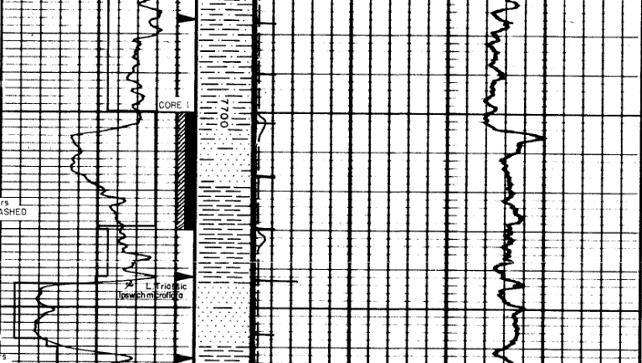
Cored interval in the Peera Peera Formation in Macumba 1 (excerpt from Composite Log)
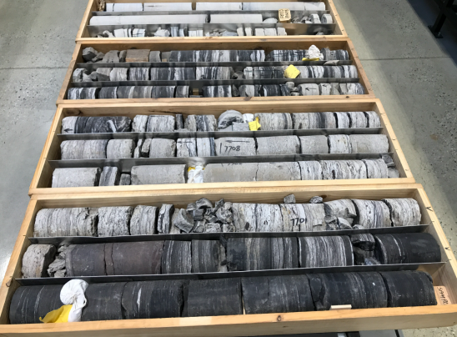
Macumba 1 Core 1 whole core photo
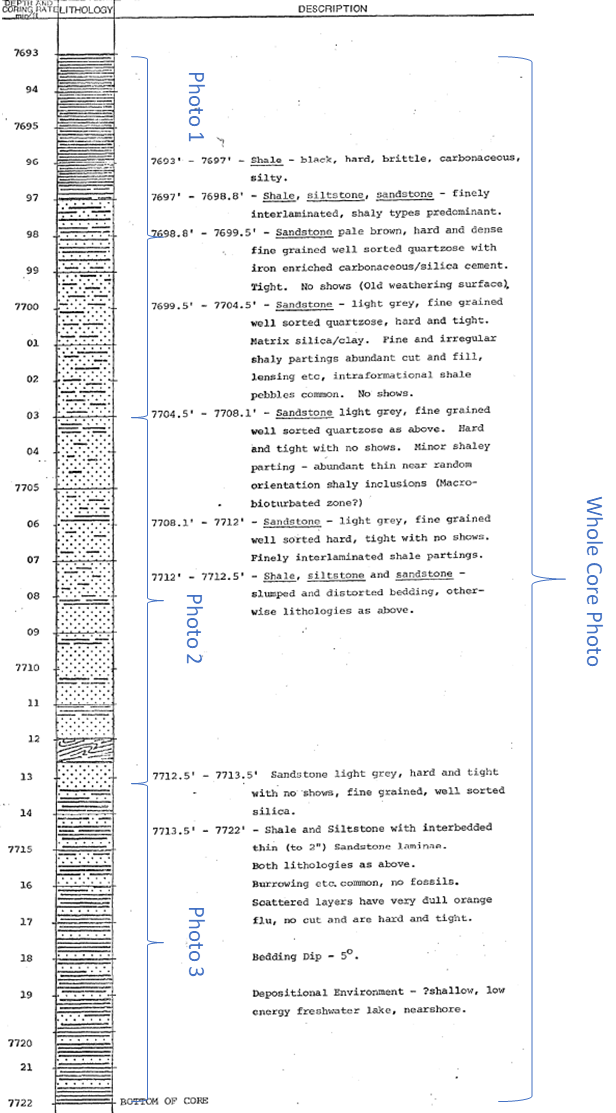
Description of Core 1 cut in the Peera Peera Formation in Macumba 1 (excerpt from WCR)
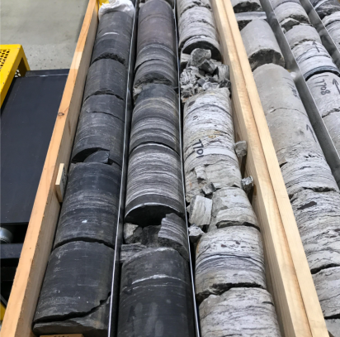
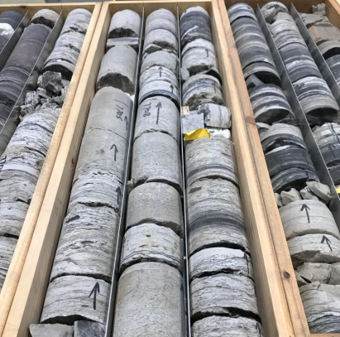
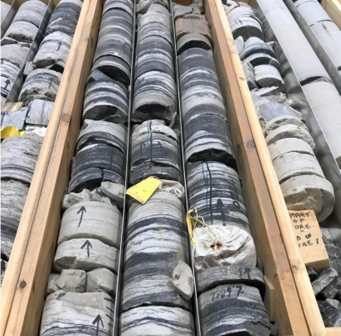
Core 1 Photos 1-3, Macumba 1
- Walkandi 1 - 27ft (8.2m) of core was cut, with 19ft 5” (5.9m) recovered. Core analysis showed that the reservoir was tight due to extensive silica cementation; sandstone porosity ranged 2.8 to 8.8% with most samples showing 6-8%, and permeability ranging from 0.06 to 0.30mD, mostly around 0.1-0.2mD.
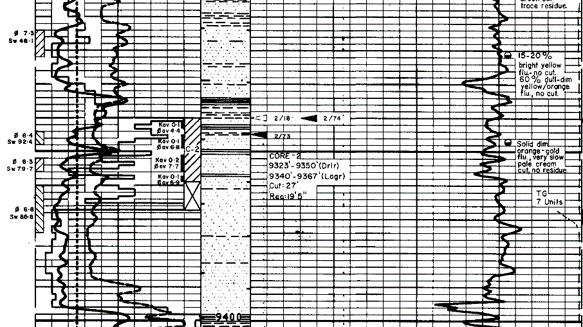
Cored interval in the Peera Peera Formation in Walkandi 1 (excerpt from Composite Log)
The only recovery of hydrocarbons from the Peera Peera was in Poolowanna 1, in which gas flowed to surface but at rate too small to measure, and 110 ft (1.6 barrels) of slightly oil cut mud was recovered. Oil fluorescence was encountered within reservoirs in the middle unit in Walkandi 1, and gas shows were also recorded in Oolarinna 1.
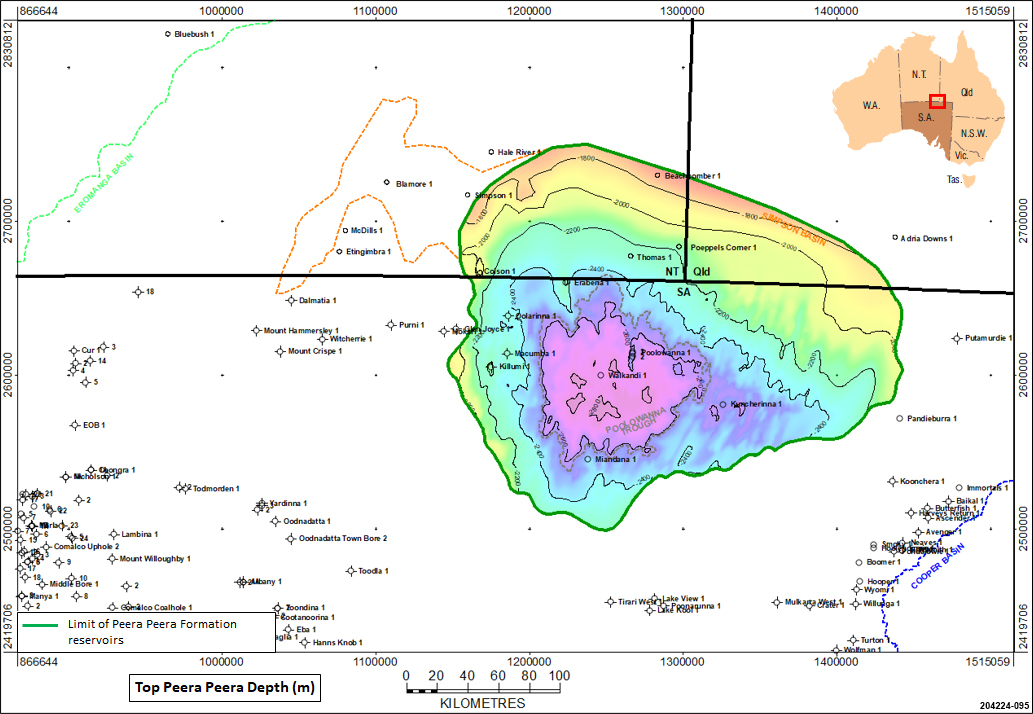
Extent of the Peera Peera Formation reservoir in the Simpson Basin
The upper unit of the Peera Peera is characterised by black carbonaceous shale, coal and thin sandstone interbeds, with “The uppermost 60 feet of this section consists of black, silty, very organic rich shale” in Poolowanna 1, which should act as a suitable topseal for reservoirs within the middle unit.
The Poolowanna 1 WCR also noted “A large sonic travel time shift (18 microseconds per foot, maximum) indicates the high organic content of this silty shale, which seems to be the main source of hydrocarbons in the area.” The sonic break which represents the base of the seal is clearly seen in the well correlation.
Stratigraphic traps may be set up by intraformational seals within the Peera Peera; oil fluorescence was encountered in several different sands in Walkandi 1.
It is possible that there are stratigraphic traps on the flanks of the Poolowanna Trough where the silts and shales at the top of the Lower Poolowanna pinch out against the silts and shales at the top of the Permian Pedirka Basin intervals below, providing top seal and lateral seal for the middle unit reservoirs of the Peera Peera.
Intense east-west compression and local wrenching during the Miocene resulted in structural rejuvenation and breach of fault seal in the Poolowanna Trough area. This would explain why only residual hydrocarbons were encountered in the Peera Peera and Poolowanna Formations in Poolowanna 1.
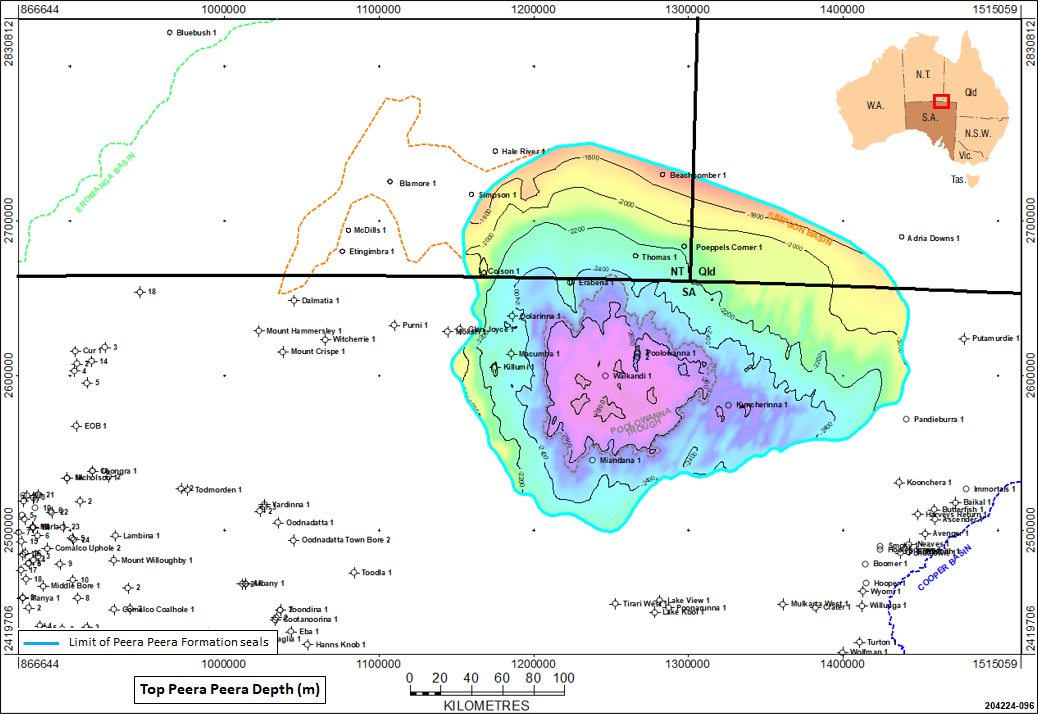
Extent of the Peera Peera Formation seals in the Simpson Basin
Gas flowed to surface and condensate recovered on DST from the Peera Peera Formation in Poolowanna 1, suggesting that the tested interval was from a gas and light oil zone.
Three intervals contain suitable material in the Simpson Basin region to have acted as potential source rocks for charge of hydrocarbons into the Peera Peera reservoirs:
- Peera Peera Formation – intraformational organic-rich shales lying adjacent and above the reservoirs are the most likely,
- the Early Permian Purni Formation of the Pedirka Basin, and
- the Early Jurassic Lower Poolowanna Formation of the Eromanga Basin
The Lower Poolowanna is stratigraphically above the Peera Peera so is likely to only have sourced hydrocarbons in potential stratigraphic closures on the flanks of the Poolowanna Trough, where it may act as a seal as well.
Peera Peera Formation, Simpson Basin
The Triassic Peera Peera Formation offers fair to good source potential. The Poolowanna 1 Well Completion Report indicated “The uppermost 60 feet of this section consists of black, silty, very organic rich shale, and appears to be an excellent source rock”, and that the formation “appears to be less prospective for liquid hydrocarbons than the Lower Jurassic section, although higher yields of kerogen have been attained in the upper part of the Peera Peera Formation.” The WCR also noted “A large sonic travel time shift (18 microseconds per foot, maximum) indicates the high organic content of this silty shale, which seems to be the main source of hydrocarbons in the area.” The sonic break is clearly seen in the well correlation.
The Peera Peera is rich in Type III kerogen organic matter (TOC around 4-5% although up to 18% in places). Ambrose et al (2007) reported Hydrocarbon Index of 100-200 with yield of 5-11kg/tonne in Macumba 1 (1977), suggesting a source for mixed gas and liquids, which is consistent with the gas flowed to surface from the Peera Peera in Poolowanna 1, albeit at a rate too small to measure. Radke (2009) noted that generally the DOM is higher towards the top of the unit and inertinite is dominant, and that much of the source potential of this unit lies in its abundant coals which have comparable macerals to those in the overlying Poolowanna Formation. He stated that the formation appears to be predominantly gas-prone but with potential for a modest oil yield.
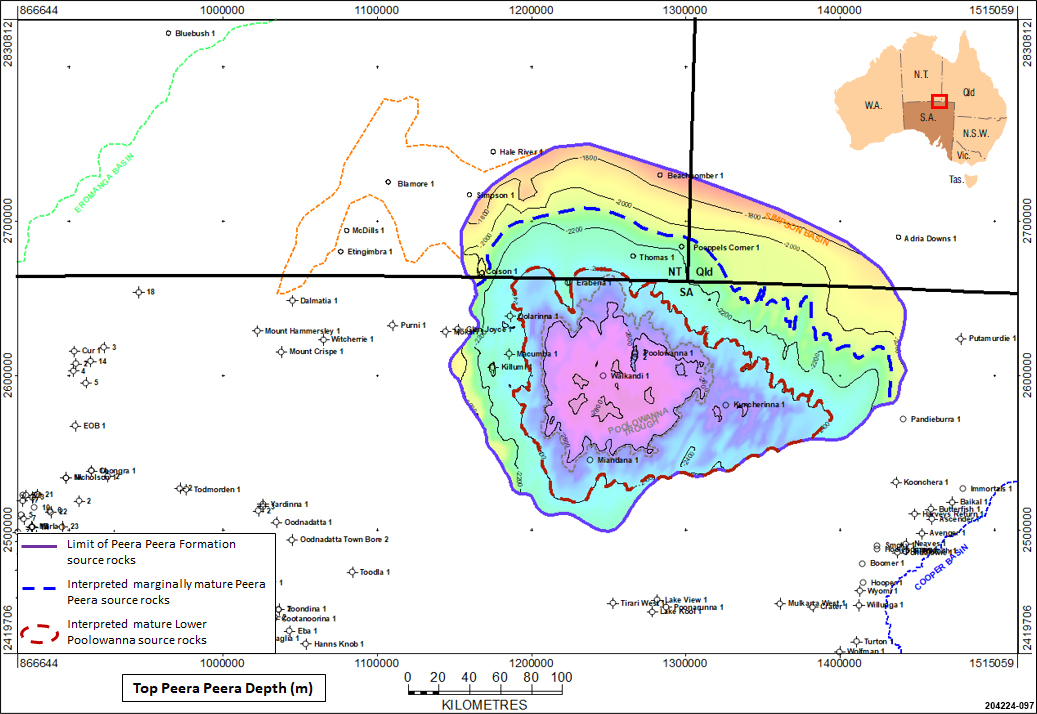
Maturity of the Peera Peera Formation source rocks in the Poolowanna Trough
Purni Formation, Pedirka Basin
The Early Permian Purni Formation in the Pedirka Basin is the equivalent of the Patchawarra Formation, which is the source for much of the gas and oil discovered in the Cooper and Eromanga Basins. It contains the richest source rocks in the Pedirka Basin-Poolowanna Trough area, with extensive coal-rich organic shale which appears to be both oil and gas-prone. It contains up to 4% dispersed organic matter, with vitrinite and exinite macerals present in moderate abundance. Data from Dalmatia 1 and Mt Hammersley 1 indicate poor to good source potential for oil in the Purni Formation.
Radke (2009) reported both the upper and lower members of the Purni Formation as having good to excellent source rock potential. They consist of alternating shale, coal and siltstones deposited in lacustrine, swamp and floodplain settings, with the coals being the richest source rocks, comprising predominantly vitrinite and inertinite, with exinite generally less than 5% (but up to 20%). DOM in carbonaceous shales is generally poor. In the eastern Pedirka, Purni Formation sediments contain both H–rich exinite and vitrinite, and H-poor vitrinite rich source rocks.
2008 drilling in the Northern Territory by Central Petroleum established extremely thick coal accumulations away from structural highs. Blamore 1 encountered thick coal seams in the upper part of the Purni Formation with a total 160m of coal in seams greater than 0.2m, also assessed to be a total 132m of coal in seams greater than 2.0m thickness. The isopach of the Purni Formation suggests there may be over 660m of section in the Eringa Trough in the Northern Territory, and the large amount of coal present had the potential to have generated reasonable quantities of hydrocarbons.
The Peera Peera Formation directly overlies Purni Formation source rocks in the western Simpson Basin. Therefore, it is likely that there would have been direct migration of hydrocarbons from the mature Purni Formation source rocks into the Peera Peera reservoirs in these areas.
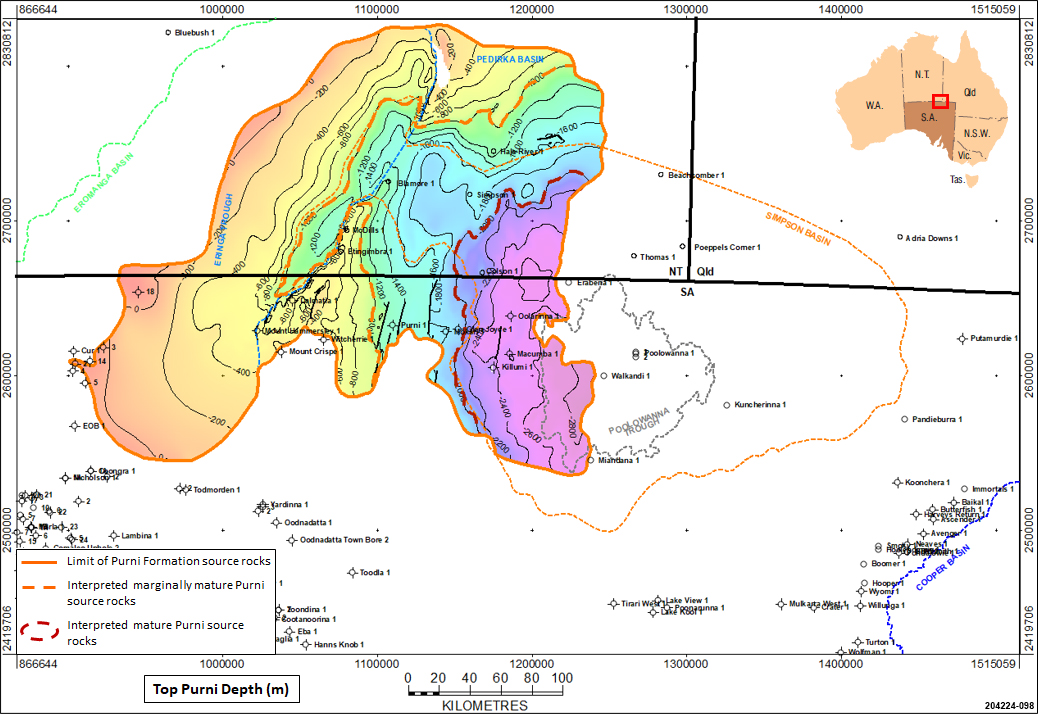
Maturity of the Purni Formation source rocks in the Pedirka Basin
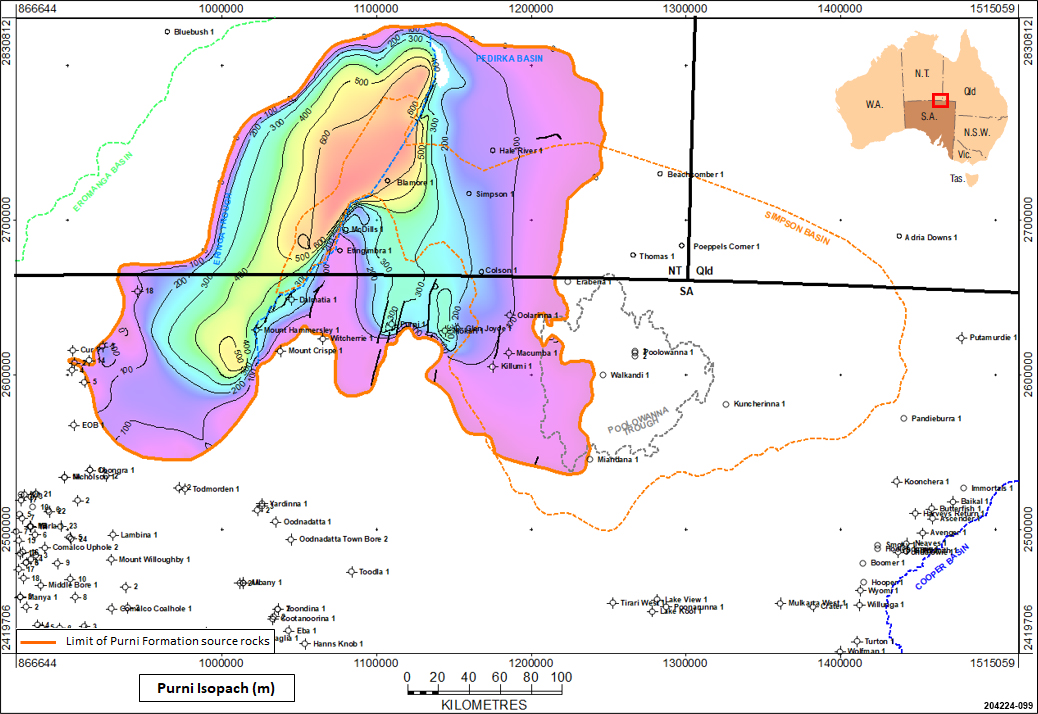
Thickness of the Purni Formation in the Pedirka Basin
Lower Poolowanna Formation, Eromanga Basin
The middle section of the Poolowanna Formation is considered to have good potential as a source rock in the Poolowanna Trough: the Poolowanna 1 Well Completion Report indicated “A 40 foot interval within the Poolowanna Formation offers the best source rock potential of the well. The kerogen from this interval included about 25 % diffuse sapropelic material that is rich in exinite, but also in inertinite.”
The Poolowanna Formation source rocks are primarily at the top of the Lower Poolowanna. Coals and coal-related lithologies are volumetrically important in the sequence, with maceral composition ranging from vitrinite and vitrinite-rich clarite through a range of trimacerites to durite (Radke, 2009). Inertinite is dominant in dispersed organic matter (DOM) but vitrinite is also abundant. At Poeppels Corner 1, woody herbaceous DOM is rich in exinite. The coals have good to excellent source richness with total organic carbon (TOC) up to 15%, possess good oil generative potential, and have reached peak maturity of 0.9 % Ro in the Poolowanna Trough.
The Lower Poolowanna is stratigraphically above the Peera Peera so is likely to have sourced hydrocarbons only in potential stratigraphic closures on the flanks of the Poolowanna Trough, where it may act as a seal as well.
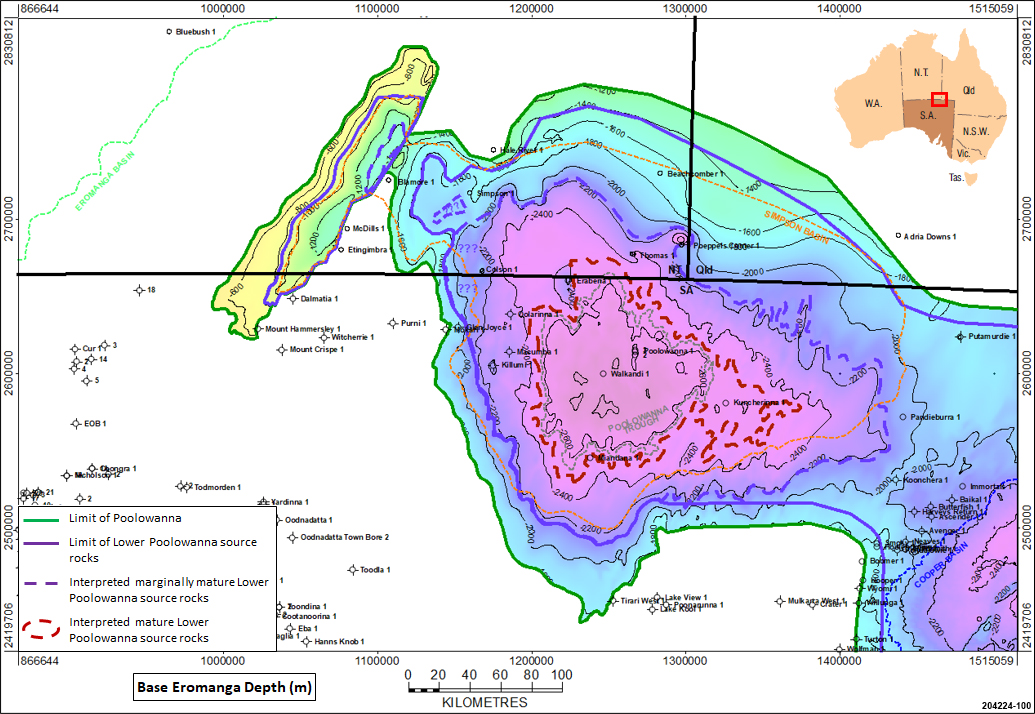
Maturity of the Lower Poolowanna Formation in the Poolowanna Trough and the Eringa Trough
Source Rock Maturity
Onset of oil generation (Ro=0.5%) would generally be expected with burial at 1500m, and peak oil generation (Ro=0.7%) at 2200m Radke (2009), although of course this depends upon the types of organic matter present and the local geothermal gradient. Gas generation is expected from 0.6% Ro at 1900m.
In much of the Pedirka Basin geothermal gradients are low and so sediments may not have generated significant quantities of hydrocarbons, but the Early Jurassic (Poolowanna) and Permo-Triassic sequences have reached the main oil generative window (Ro 0.7-0.9%) over large portions of the Pedirka Basin and Poolowanna Trough.
Basin modelling in the Poolowanna Trough by Ambrose et al (2007) suggested that early onset of oil generation commenced from the Peera Peera Formation in the Early Cretaceous around 135Ma, with peak generation and expulsion from the Poolowanna source rocks primarily during the early part of the Late Cretaceous (100-90Ma) following significant subsidence during the deposition of the Winton Formation.
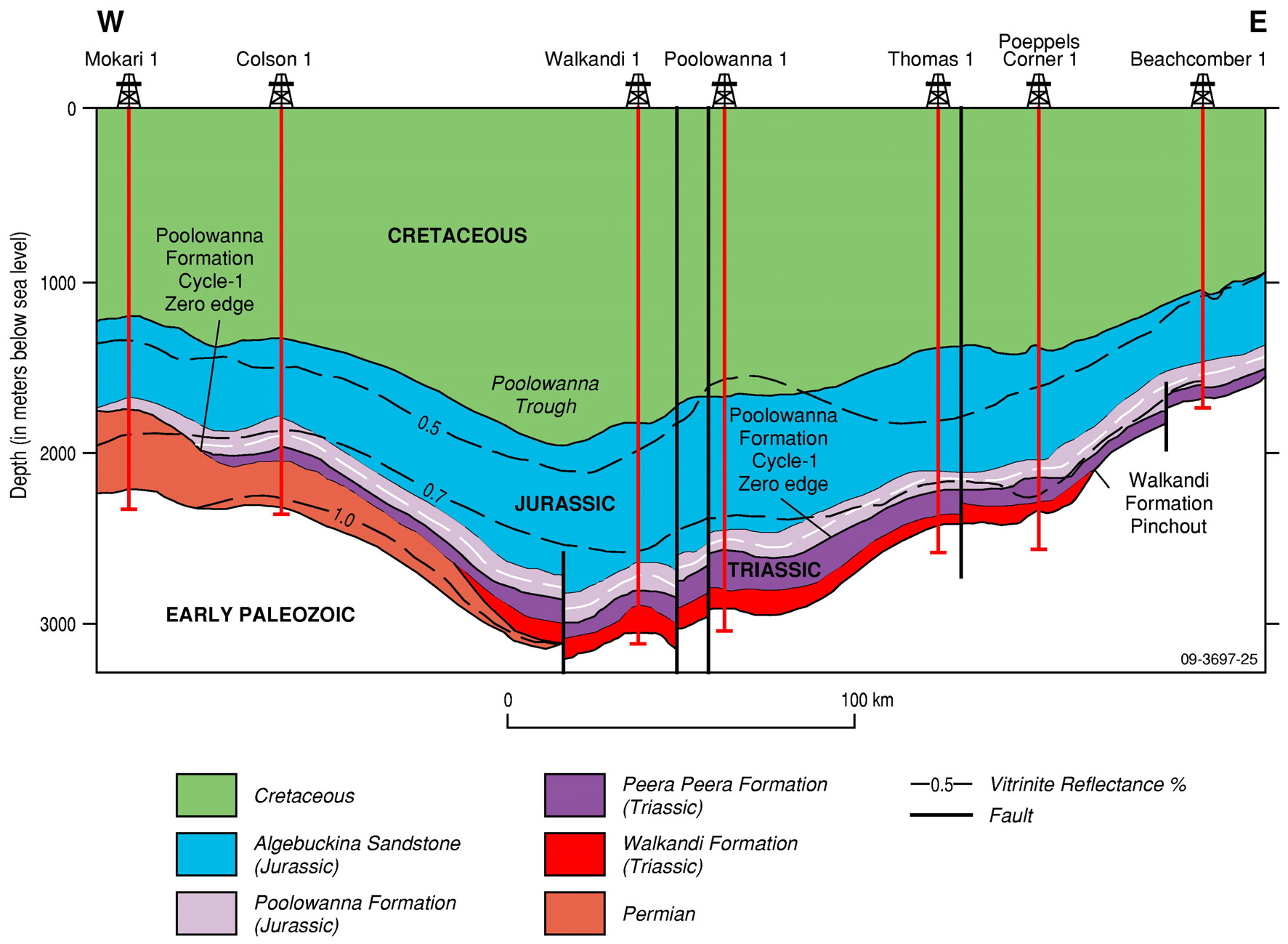
Cross section of the Poolowanna Trough with isoreflectance contours, showing maturity of the sequence up to the basal Jurassic, and a progressively shallower mature sequence to the east (from Radke, 2009, modified from Ambrose et al, 2007).
Three intervals contain suitable material in the Simpson Basin area to have acted as potential source rocks for charge of hydrocarbons into the Peera Peera reservoirs:
- Direct charge from Peera Peera source rocks into underlying Peera Peera reservoirs in the Simpson Basin
- The middle Peera Peera sandstone reservoirs are directly overlain by potential source rocks of the same age, and therefore charge into reservoirs is likely from areas where the source is mature, including updip of the mature source due to the porous and permeable carrier bed system
- Peera Peera source rocks are mature over most of the Simpson Basin
- Vertical migration from Purni source rocks into the directly overlying Peera Peera reservoirs in the western Simpson Basin
- The Peera Peera Formation directly overlies Purni Formation source rocks in the western Simpson Basin. Therefore, it is likely that there would have been direct migration of hydrocarbons from the mature Purni Formation source rocks into the Peera Peera reservoirs in these areas
- Lateral charge from Lower Poolowanna source rocks in the Poolowanna Trough into Peera Peera reservoirs in the Simpson Basin
- The Lower Poolowanna is stratigraphically above the Peera Peera so may have sourced hydrocarbons in potential closures on the flanks of the Simpson Basin
- This could occur on the western and north-eastern flanks of the Simpson Basin
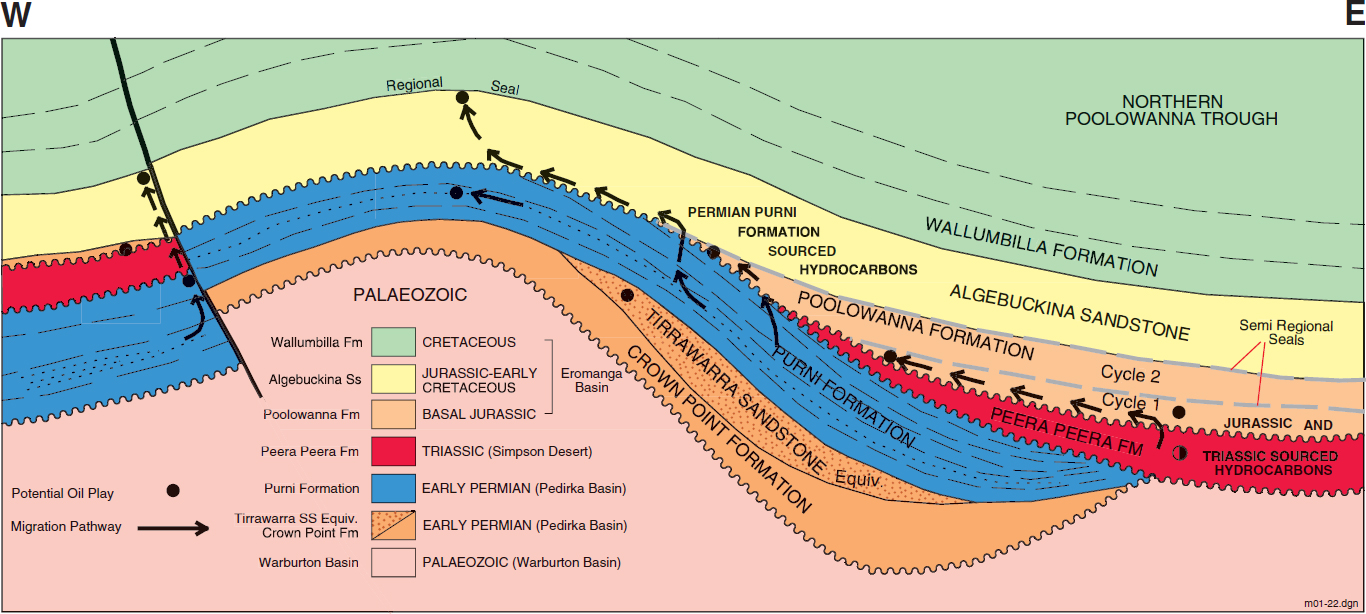
Pedirka, Simpson and Eromanga Basins play types and potential migration pathways (Ambrose et al, 2002)
Up to 20km migration distance from mature source rocks is generally regarded as a reasonable migration distance within porous reservoirs, although Borazjani et al (2019) stated that in the Cooper-Eromanga basins “the migration of expelled oils to Jurassic reservoirs was relatively fast given the short pathway distances of <1 km (fault migration) and ~40 km (carrier bed pathway)”. In this play analysis study 20km migration distances have been used outboard of mature source rock areas.
|
|
|
Trapping mechanisms in the Simpson Basin are likely to be dominated by anticlines with 4-way dip closure over pre-existing, “basement” highs.
Structures to be investigated must have been in place prior to major generation and expulsion of hydrocarbons, so those that formed during the Cainozoic are less favourable prospects than those formed prior to end of deposition of the Winton Formation.
Intense east-west compression and local wrenching during the Miocene resulted in structural rejuvenation and breach of fault seal in the Poolowanna Trough area. This would explain why only residual hydrocarbons were encountered in the Poolowanna Formation in Poolowanna 1. Therefore, exploration is required of more subtle structures not affected by the reactivation in the Miocene.
Stratigraphic traps are also potential targets, in particular pinch-outs on the flanks of the basin.
In the Cooper-Eromanga Basins a common technique for estimating whether a present day structure is likely to have been charged with hydrocarbons or not is to look at the isopach between the top of the Winton Formation and the top of the target formation; this map approximates the target surface structure at time of migration, with thin isopach areas indicating potential structures at time of migration. If there is no top Winton surface mapped in the area of interest the isopach between the top of the Cadna-owie Formation and the target formation is used as a proxy. This technique is applicable in the Simpson Basin as well.
Eromanga Basin structures in South Australia and Queensland are typically not filled with oil to spill; net oil columns are relatively thin compared to the area under closure. This is due to compressive deformation in the early/mid-Tertiary reactivating older structures, and is an important concept given that exploration in the area, and in particular seismic acquisition, has focused on large structures. The same may apply to the Peera Peera Formation in the Simpson Basin.
It must be borne in mind that the coverage of 2D seismic data within the Poolowanna Trough and the Eringa Trough is limited compared to that in the Cooper Basin to the south-east. Consequently, structures in reality may be quite different to the way they have been mapped.
|
|
| 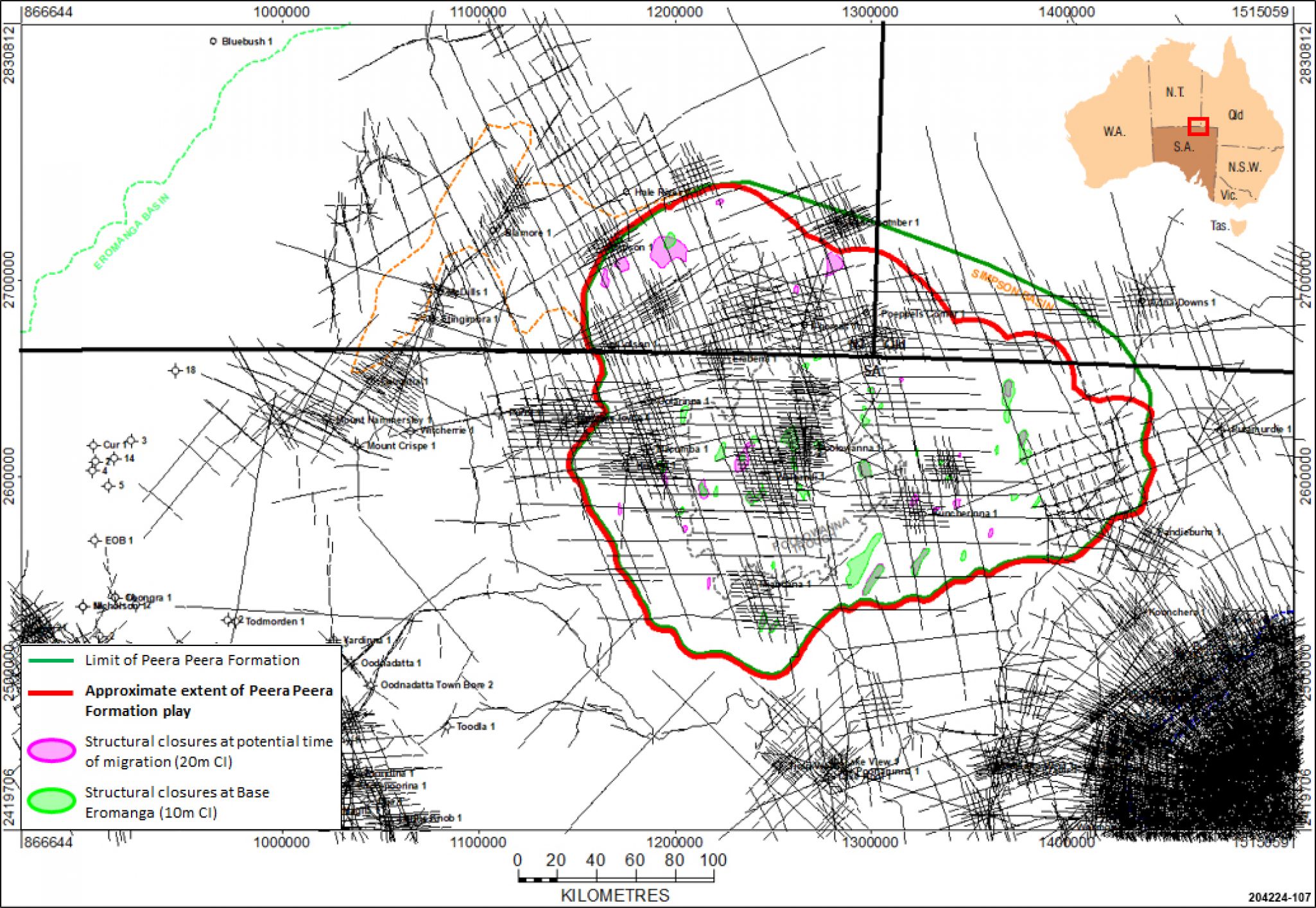 |
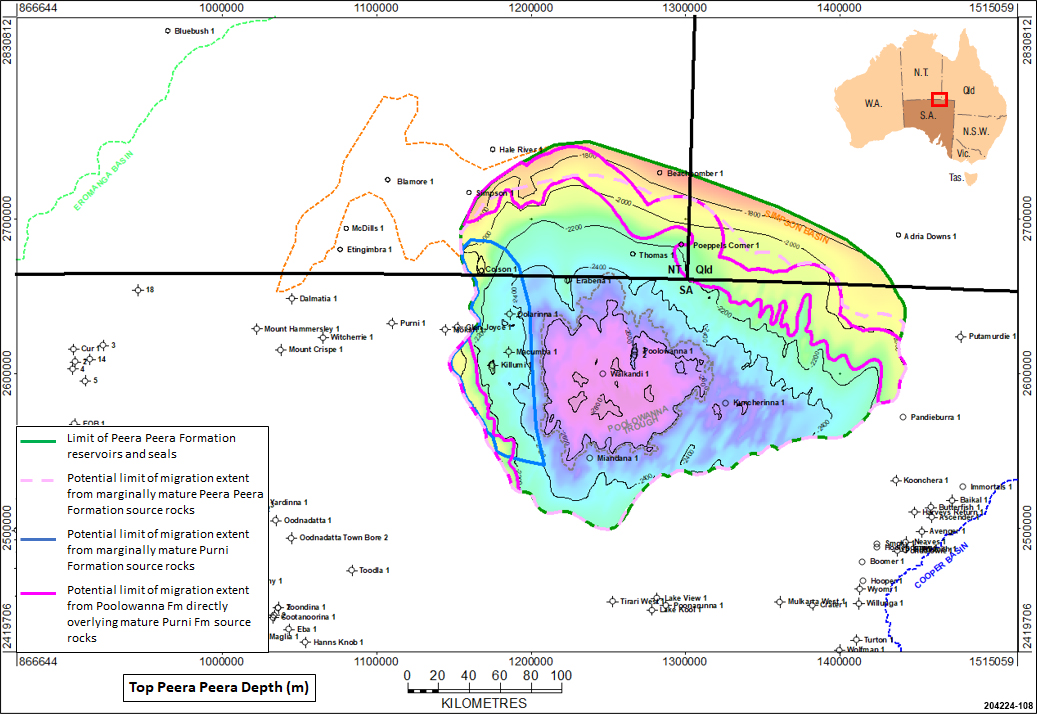
Play elements for the Peera Peera Formation in the Simpson Basin
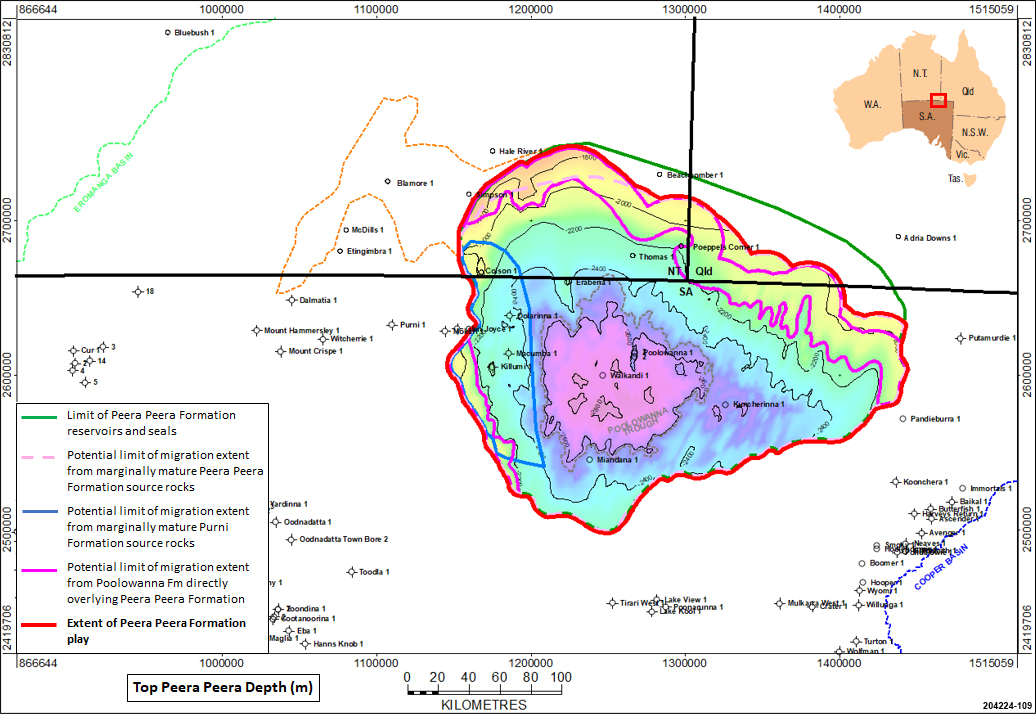
Approximate extent of the Peera Peera Formation in the Simpson Basin
| Proven production from the Poolowanna: | None; gas flowed at RTSTM and slightly oil cut mud recovered in Poolowanna 1 |
| Number of producing wells at 28 February 2021: | None |
| Total production at 28 February 2021: | None |
| Hydrocarbon flow rates: | No rate proven other than gas to surface at RTSTM |
Currently there is no estimate of undiscovered resources.
Alexander, EM, and Jensen-Schmidt, B, 1995: Eringa Trough exploration opportunity; South Australia. Department of Mines and Energy. Report Book, 95/00036.
Alexander, EM and Boult, PB, 2007. Reservoirs and seals; Chapter 11 in Cotton, TB, Scardigno, MF, and Hibburt, JE, eds: The Petroleum Geology of South Australia. Vol. 2: Eromanga Basin. 2nd edn; South Australia; Department of Primary Industries and Resources. Petroleum Geology of South Australia Series.
Alexander, EM, Sansome, A and Cotton, TB, 2007. Lithostratigraphy and environments of deposition; Chapter 5 in Cotton, TB, Scardigno, MF, and Hibburt, JE, eds: The Petroleum Geology of South Australia. Vol. 2: Eromanga Basin. 2nd edn; South Australia; Department of Primary Industries and Resources. Petroleum Geology of South Australia Series.
Ambrose, GJ, Liu, K, Deighton, I, Eadington, PJ, and Boreham, CJ, 2002: New petroleum models in the Pedirka Basin, Northern Territory, Australia; The APPEA Journal, 42(1): 259-286.
Ambrose, G., Scardigno, M., and Hill, A.J., 2007: Petroleum geology of Middle-Late Triassic and Early Jurassic sequences in the Simpson Basin and northern Eromanga Basin of Central Australia; The APPEA Journal, 47(1): 125-142.
Borazjani, S, Kulikowski, D, Amrouch, K and Bedrikovetsky, 2019: Composition changes of hydrocarbons during secondary petroleum migration (case study in Cooper Basin, Australia); Geosciences, 9(2), 78
Carne, GE and Alexander, EM, 1997: Eromanga Basin prospects inventory, Blocks ER97-A to C, Exploration opportunity; South Australia. Department of Mines and Energy Resources. Report Book, 97/00021.
Giuliano MF, 1988. The geology and hydrocarbon potential of the Pedirka Basin. University of Adelaide. National Centre for Petroleum Geology and Geophysics. BSc (Hons) thesis (unpublished).
Radke, B., 2009: Hydrocarbon & Geothermal Prospectivity of Sedimentary Basins in Central Australia. Record 2009/25. Geoscience Australia, Canberra.
Strong, P.C. 2024. Play analysis in the Pedirka Basin-Poolowanna-Trough region. Central Australian Basins Symposium IV, Vol 2. PESA.


